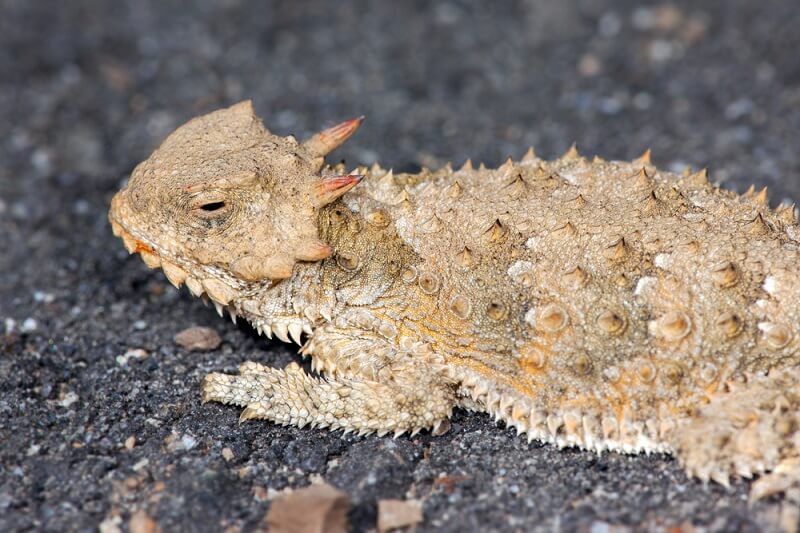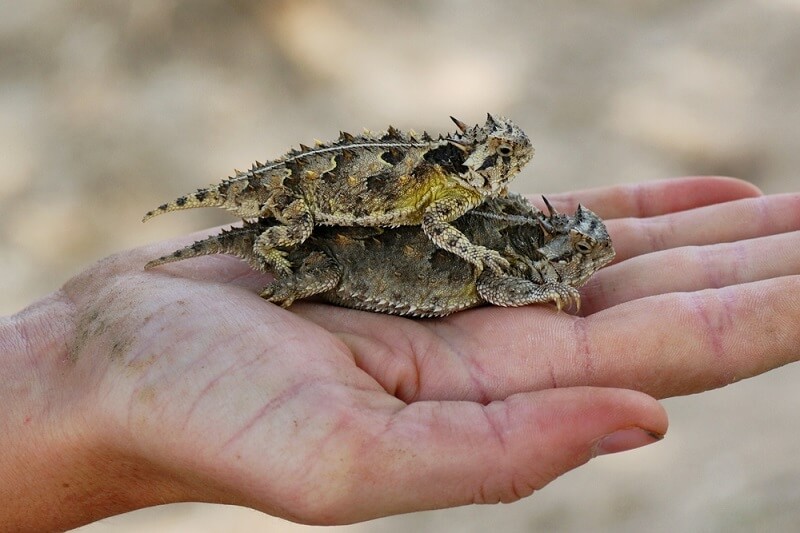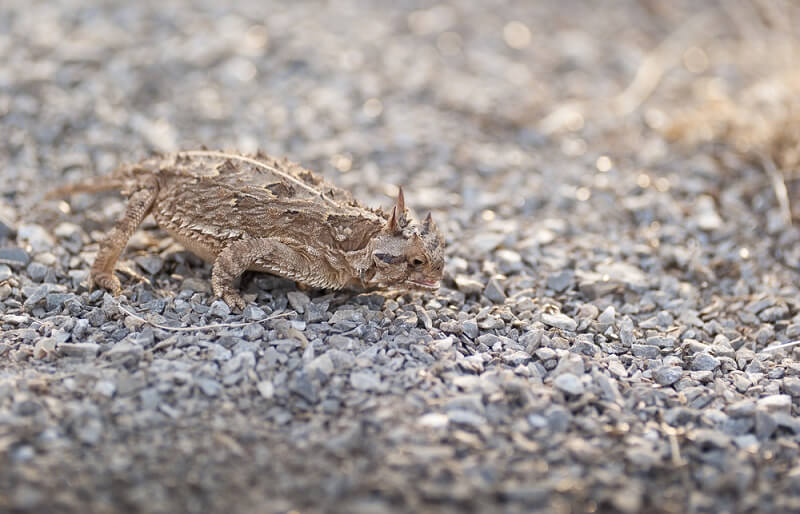
Horny Toads are a genus of lizard adapted to the desert that boasts a number of large horns on the backside of their skull. Horny toads are in the genus Phrynosoma – meaning “toad-bodied” – a reference to the very short tails of horny toads. There are around 22 different species, found mostly throughout North and Central America. Horny toads are typically solitary animals that spend their days wandering the desert looking for insects to eat. Horny toads often focus on ants, as anthills can provide a large source of food. Compared to other insects, ants contain lots of indigestible fiber. To compensate, horny toads have very large bellies that they can pack full of ants. In fact, to catch ants horny toads will often bury themselves in the sand and gravel near an anthill. When the ants start a line near the horny toad, it will gentle reach out and lick up each ant as it passes. Since the ants are picked up before they can release alarm signals, the next ant is none-the-wiser. Horny toads can eat large amounts of ants in this way. Horny toads are not only famous for their odd shape, but also for their incredible defenses. The “horns” on the head are actually extensions of the skull. This makes them a very formidable obstacle for most small mammals and birds. Not only can they be used to protect the neck, but they present a choking hazard to any animal trying to swallow a horny toad. The spines on the back and sides are not filled with bone but are still very hard and sharp modified scales and provide another level of protection. Around half of all horny toad species also have a very disturbing defense – the ability to squirt blood. The exact reason for this defense has not been determined, though it has been noted that dogs and cats show a high aversion to the blood. Scientists theorize that the blood contains noxious compounds from the ants a horny toad eats. Keeping a horny toad as a pet is not advisable for several reasons. First and foremost, many horny toad species are protected by local law and cannot be removed from the wild or handled in any way. In most places, there is no legal way to even acquire a horny toad. On the rare chance that you live in a place where it is legal to collect horny toads, you should consider this action carefully. Not only will you be reducing the wild population, but horny toads are very hard to care for. Oftentimes, horny toads in different areas focus on different types of ants. Most ant species are not easy to rear in captivity, so you will quickly run out of food. If you like horny toads and want to see more on your property, consider attracting more ants. This can be accomplished by planting certain types of plants that the ants eat, which varies by region and species. With a little research, you can find out which species of horny toad lives in your area, what ants it eats, and what plants they are attracted to! Interesting Insights from the Horny Toad! Horny toads are not just fascinating because they have horns and squirt blood. Behind all that dramatic flare lies some truly incredible biological concepts. Let’s see what the horny toad can teach us about biology in general! One theory supported by several prominent herpetologists is that horny toad blood repels dogs and cats because it contains compounds obtain from ants. Ants of different species generate all sorts of volatile compounds as a predator defense. If horny toads eat these ants, they have likely developed a counter-measure to these otherwise-toxic compounds. The theory suggests that the counter-measure includes storing the toxin in their blood. When a horny toad feels threatened, it will block blood from leaving the head area. The build-up of pressure forces the blood out of a thin blood vessel in the corner of the eye – shooting blood up to 5 feet! This blood-repellent is a form of adapting a toxin from a prey species into a defense against a predator species. Horny toads are one of many species that have adapted this defense. Monarch butterflies and poison dart frogs are two other species that derive their toxin from the things they eat. Nudibranchs take it one step further. Nudibranchs eat corals – which have tiny stinging cells. Nudibranchs do not digest these cells. Instead, these tiny stinging cells are transferred to special organs, where they are arranged to face outward as a defense mechanism for the nudibranch! Myrmecophagy literally means “ant-eating.” The Greek myrmex means “ant”, where an word ending in –phagy refers to a method of eating or taking in nutrients. An organism that eats only or mostly ants is referred to as a myrmecophagous organism. Unlike more general insectivores, an organism that eats only ants must have some specialized adaptations. The horny toad, for instance, has a very sticky tongue and an extra-large stomach to catch and process the large number of ants it needs to survive. But, horny toads are far from the only animals that rely solely on ants and termites as a food source. Antbirds, blindsnakes, narrow-mouthed toads, anteaters, and pangolins are just some of the many species that rely on this one type of insect. Due to their dietary restrictions, many of these species are hard to keep in captivity. Reptiles and amphibians all across the globe are in decline, and horny toads are no exception. Studies in places like Texas and Oklahoma have shown that their populations are declining by massive amounts – despite being protected by some laws. Experts think that two main factors are driving their decline: habitat destruction and loss of prey. Horny toads generally wander far distances in search of the next anthill, a process that is often interrupted by human development, roads, and homes. As humans expand further and further into arid environments, we further restrict the habitat of horny toads. Second, ants are often considered a pest and have seen heavy declines as humans move into natural areas. Some insecticides are extremely effective and -unfortunately – can remain in the environment for years after they are first applied. This not only ensures that horny toads lose a food source one year – but that ants will generally avoid that area for many years to come. This drastically affects the availability of food and a horny toad’s ability to survive harsh desert environments.
Kingdom
Animalia
Phylum
Chordata
Class
Reptilia
Order
Squamata
Family
Iguania
Genus
Phrynosoma
Species
22 different species!
Niche
Myrmecophagous – eats mainly ants!
Length
Up to 4 in (100 mm)
Weight
<1 lb (<2.2 kg)
Lifespan
5-8 Years
Social Structure
Solitary
Conservation Status
Some protected, many species declining
Preferred Habitat
Arid regions, scrubland, deserts
Average Clutch Size
Around 15 eggs
Main Prey Species
Ants, some other insects
Predators
Birds, Mammals – many predators
The Basics
Squirting Blood and Other Defenses

Horny Toad as a Pet?!
Toxin Transfer as a Defense
Myrmecophagy – Ant-Eating!

Population Decline

